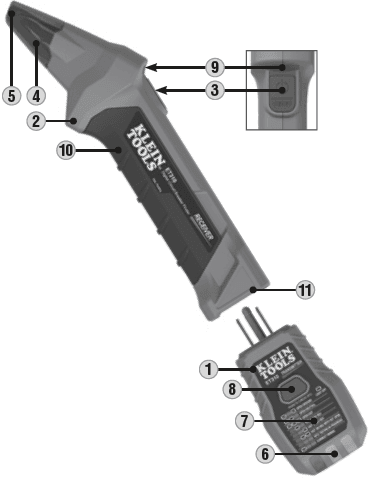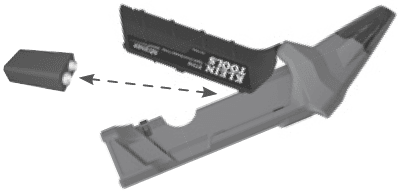
Klein Tools ET310 Digital AC Circuit Breaker Finder

FEATURE DETAILS
- Transmitter
- Receiver
- Power On/Off/Reset Button
- Power On Indicator
- Sensing Tip
- Wiring Condition Indicators
- Wiring Condition Codes
- GFCI Test Button
- Circuit Status Indicator
- Battery Door
- Transmitter Docking Receptacle
NOTE: There are no user-serviceable parts inside.
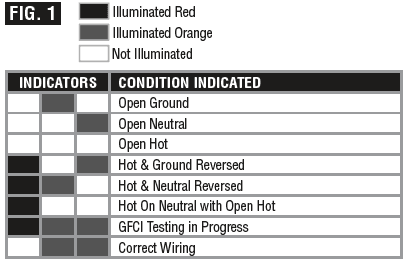
WARNINGS
To ensure safe operation and service of the meter, follow these instructions. Failure to observe these warnings can result in severe injury or death.
- Failure to follow instructions could result in death or serious injury.
- Prior to use, always verify tester operation by testing on a known live and correctly wired electrical outlet.
- DO NOT use if the tester appears damaged in any way.
- The tester is intended for indoor use only.
- The tester is designed for use with 120V AC electrical systems. DO NOT connect to higher voltage electrical supplies.
- Other equipment or devices attached to the circuit being tested could interfere with the tester, clear the circuit before testing.
- This tester only detects common wiring problems. Always consult a qualified electrician to resolve wiring problems.
- If using accessories to connect to bare wires, ensure that the circuit is not energized before inspecting, applying, or removing the transmitter.
- Exercise extreme caution around energized bare wires, especially when working in or around an open breaker panel.
OPERATING INSTRUCTIONS
POWER ON/OFF
Press the Power button 3 to power on the receiver 2; press and hold the Power button 3 to power off the receiver. A green indicator 4 illuminated in the Sensing Tip 5 and pulsing audible beep indicates that the unit is powered ON. The receiver will automatically power off following 3 minutes of inactivity. Transmitter 1 is powered by the circuit when inserted into an energized electrical outlet.
WIRING CONDITION
Prior to using this tester, always verify proper operation by testing the transmitter on a known energized and correctly wired electrical outlet.
Insert transmitter 1 into the electrical outlet being tested and compare the illuminated wiring condition indicators 6 with the wiring condition codes 7 printed on the transmitter (FIG. 1).
If the tester indicates that the outlet is not wired correctly, consult a qualified electrician.
NOTE: Conditions NOT indicated include but are not limited to quality of ground, multiple hot wires, reversal of neutral and ground conductors, dual open ground and neutral, and other combinations of defects.
NOTE: All appliances or equipment on the circuit being tested should be unplugged to help reduce the possibility of erroneous readings.
GFCI TEST
NOTE: Check the GFCI device’s user manual for information on how the specific device operates prior to using this tester.
NOTE: All appliances or equipment on the circuit being tested should be unplugged to help reduce the possibility of erroneous readings.
NOTE: Not designed for testing 30mA ground-fault devices. Insert the transmitter into the electrical outlet and note the wiring conditions 6 & 7.
If the tester indicates that the outlet is not wired correctly, DO NOT attempt to test the GFCI device. Consult a qualified electrician.
Press the GFCI button 8 on transmitter 1 to test the GFCI device. Following the test:
- If the GFCI device tripped, de-energizing the circuit, the wiring condition indicators 6 will all be off (Open Hot). Reset the GFCI device by pressing its reset button. After reset, the transmitter should indicate Correctly Wired 6 & 7. The GFCI device appears to be functioning correctly.
- If the circuit remains energized, the GFCI device didn’t trip, indicating that it may be incorrectly wired, may not be installed correctly, or may not be functioning correctly. Consult a qualified electrician.
FINDING CIRCUIT BREAKERS
Insert transmitter 1 into the electrical outlet and note the Wiring conditions 6 & 7. If the transmitter indicates that the outlet is energized and correctly wired, prepare to scan the breakers in the breaker panel with the receiver 2.
If the tester indicates that the outlet is not wired correctly, cease testing and consult a qualified electrician.
Power ON the receiver. Before approaching the electrical panel, push the Power On/Off/Reset button 3 once to reset the receiver. Position the receiver so that the sensing tip 5 is oriented perpendicular to the breakers in the panel. Slowly scan all breakers in the panel once, ignoring any audible or visual indications as the receiver is learning the panel.
Scan all breakers a second time. When the breaker connected to the circuit with the transmitter is approached, the frequency of the audible beeps will increase. When located, the audible beep will sound continuously, the circuit status indicator will illuminate red 9, and the green indicator in the sensing tip 4 will turn off, indicating that the correct breaker has been found.
NOTE: Resetting the receiver erases prior scanning data stored from a previously ‘learned’ panel. Always reset the receiver away from the electrical panel to ensure that electrical signals are not being sensed during the reset operation.
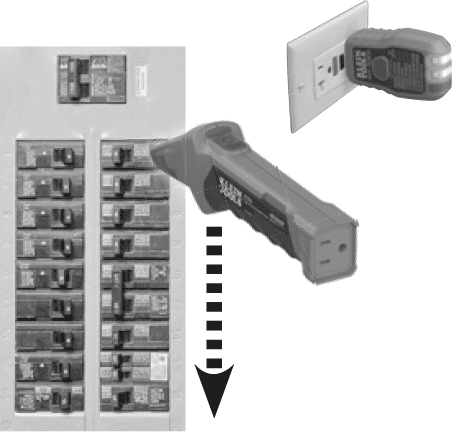
CONNECTING TO OTHER FIXTURES USING OPTIONAL ACCESSORIES (CAT. NO. 69411)
LIGHT SOCKET FIXTURES
Screw the light fixture adapter into an empty light socket. Connect the transmitter 1 to the 3-to-2 prong adapter, and connect this to the light fixture adapter. The indicators on the transmitter will communicate an open ground wiring condition if the light socket is energized. Follow the instructions in the FINDING CIRCUIT BREAKERS section to find the correct circuit breaker.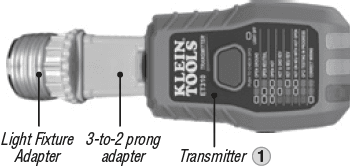
BARE WIRES
The transmitter may be connected to bare wires using the outlet-to-alligator-clip wire adapter. Carefully attach the alligator clips to the correct wires. Insert transmitter into the outlet on the wire adapter. The indicators on the transmitter will communicate an open ground wiring condition if the wires are energized. Follow the instructions in the FINDING CIRCUIT BREAKERS section to find the correct circuit breaker.
Exercise extreme caution when working around energized bare wires.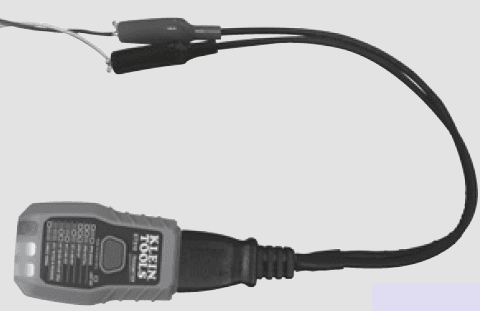
MAINTENANCE
BATTERY REPLACEMENT
When the Power-On indicator 4 blinks, the battery must be replaced.
- Open the battery compartment door 10 by unscrewing the locking screw.
- Remove the exhausted 9V battery and dispose of it appropriately.
- Replace the 9V battery, close the battery door, and re-fasten the locking screw.

CLEANING
Be sure the unit is turned off and wipe it with a clean, dry, lint-free cloth. Do not use abrasive cleaners or solvents. Take care to keep the sensor lens clean at all times. If required, loose debris may be removed from the lens using clean compressed air. The lens may also be cleaned using a soft cloth or cotton swab with water or rubbing alcohol only. The lens must be allowed to dry completely prior to use.
STORAGE
The transmitter 1 may be docked in the transmitter receptacle 11 in the receiver 2 for convenient storage. Remove the batteries when the tester will not be used for a prolonged period of time. Do not expose to high temperatures or humidity. After a period of storage in extreme conditions exceeding the limits mentioned in the General Specifications section, allow the tester to return to normal operating conditions before using.
WARRANTY
DISPOSAL / RECYCLE
Do not place equipment and its accessories in the trash. Items must be properly disposed of in accordance with local regulations. Please see www.epa.gov or www.erecycle.org for additional information.
CUSTOMER SERVICE
KLEIN TOOLS, INC.
450 Bond Street Lincolnshire, IL 60069 1-877-775-5346
customerservice@kleintools.com
For more Manuals by Klein Tools, visit ManualsLibraryy
Klein Tools ET310 Digital AC Circuit Breaker Finder-FAQs
What is the range of the Klein Circuit Breaker Finder?
The Klein ET310 Circuit Breaker Finder has a range of up to 1,000 feet, allowing you to detect breakers from a considerable distance. A flashing arrow on the display helps you locate the correct breaker easily.
Can the Klein Circuit Breaker Finder work without power?
No, it requires the circuit to be powered. The tool only works on live (powered) circuits and will not function if the breaker is off or if there’s a broken line.
How is a circuit breaker’s capacity measured?
Circuit breakers are measured by their amperage rating, which indicates how much current they can handle. Most household breakers are rated at 15 or 20 amps, and they typically operate safely at up to 80% of their rated capacity.
What does an “open neutral” mean?
An open neutral indicates a broken or loose connection in the neutral wire of a circuit. To fix it, you’ll need to inspect junction boxes and reconnect or secure the faulty wire.
How much clearance is required around a circuit breaker panel?
You need at least 3 feet of clear space in front of a circuit breaker panel. The panel should also be mounted between 4 feet and 6 feet 7 inches above the ground and be fully accessible.
Can a circuit operate without a battery or power source?
No, a circuit needs a power source (like a battery or electrical supply) to function. It also requires a complete path (circuit) for electricity to flow.
Why do circuit breakers stop working or trip?
Circuit breakers trip due to overloading—when too much current flows through the circuit. Most household breakers handle either 120V or 240V, and exceeding that causes the breaker to trip for safety.
What’s the difference between control (CTL) and non-control (non-CTL) breakers?
CTL breakers have a built-in rejection feature that limits where they can be installed. Non-CTL breakers lack this feature, making them compatible with any open slot in a load center.
What does “open hot” mean in an outlet?
An open hot outlet has a problem with the hot wire connection. This can cause the outlet to stop working even if the neutral and ground wires are connected properly.


